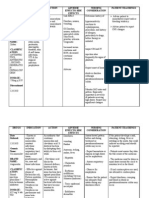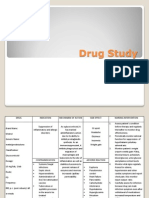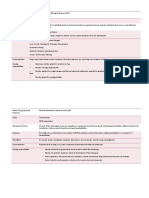0 ratings0% found this document useful (0 votes)
92 viewsDocument - Drug Card One
Document - Drug Card One
Uploaded by
Linda AdamsonThis drug study card summarizes information about the antibiotic cephalexin. It is classified as a first-generation cephalosporin antibiotic used to treat a variety of bacterial infections, including skin infections, pneumonia, ear infections, urinary tract infections, and bone/joint infections. It works by binding to the bacterial cell wall membrane and causing cell death. Important information is provided about dosing, administration, potential side effects, drug interactions, and nursing implications.
Copyright:
Attribution Non-Commercial (BY-NC)
Available Formats
Download as RTF, PDF, TXT or read online from Scribd
Document - Drug Card One
Document - Drug Card One
Uploaded by
Linda Adamson0 ratings0% found this document useful (0 votes)
92 views3 pagesThis drug study card summarizes information about the antibiotic cephalexin. It is classified as a first-generation cephalosporin antibiotic used to treat a variety of bacterial infections, including skin infections, pneumonia, ear infections, urinary tract infections, and bone/joint infections. It works by binding to the bacterial cell wall membrane and causing cell death. Important information is provided about dosing, administration, potential side effects, drug interactions, and nursing implications.
Copyright
© Attribution Non-Commercial (BY-NC)
Available Formats
RTF, PDF, TXT or read online from Scribd
Share this document
Did you find this document useful?
Is this content inappropriate?
This drug study card summarizes information about the antibiotic cephalexin. It is classified as a first-generation cephalosporin antibiotic used to treat a variety of bacterial infections, including skin infections, pneumonia, ear infections, urinary tract infections, and bone/joint infections. It works by binding to the bacterial cell wall membrane and causing cell death. Important information is provided about dosing, administration, potential side effects, drug interactions, and nursing implications.
Copyright:
Attribution Non-Commercial (BY-NC)
Available Formats
Download as RTF, PDF, TXT or read online from Scribd
Download as rtf, pdf, or txt
0 ratings0% found this document useful (0 votes)
92 views3 pagesDocument - Drug Card One
Document - Drug Card One
Uploaded by
Linda AdamsonThis drug study card summarizes information about the antibiotic cephalexin. It is classified as a first-generation cephalosporin antibiotic used to treat a variety of bacterial infections, including skin infections, pneumonia, ear infections, urinary tract infections, and bone/joint infections. It works by binding to the bacterial cell wall membrane and causing cell death. Important information is provided about dosing, administration, potential side effects, drug interactions, and nursing implications.
Copyright:
Attribution Non-Commercial (BY-NC)
Available Formats
Download as RTF, PDF, TXT or read online from Scribd
Download as rtf, pdf, or txt
You are on page 1of 3
DRUG STUDY CARD
GENERIC NAME: cephalexin
TRADE NAME(S): Keflex, Apo-Cephalex, Novo-Lexin, Nu-
Cephalex
CLASSIFICATION: THERAPEUTIC: anti-infective -
PHARMACOLOGIC :1ST Generation cephalosporins
THERAPEUTIC ACTION(S)/EFFECT(S): Bactericidal action
against susceptible bacteria. Bind to bacterial cell wall
membrane, causing cell death.
USES/INDICATIONS: Treatment of: Skin infections-
Pneumonia-Ottis media-Urinary tract infections-Bone and
Joint infections-Septicemia. Not suitalble for the treatment
of meningitis.
CONTRAINDICATIONS/CAUTIONS:
Contraindicated in: Hypersensitivity to cephalosporins.
serious hypersensitivity to penicillins.
Use Cautiously In: Renal impairment- History of G.I.
disease- Geriatric patients (consider age, wt., body mass,
current medications, and chronic disease states) OB-
Pregnancy or lactation (half-life is shorter and blood levels
lower).
NORMAL DOSAGE AND ROUTE(S):
PO (ADULTS): Most infections - 250-500 mg q 6 hr.
Uncomplaicated cystitis, skin and soft tissue infections,
streplococcal pharyngitis -500 mg q 12 hr.
PO (CHILDREN): Most infections- 25-50 mg kg/day divided
q 6-8 hr.
PHARMACOKINETICS: Absorption-Rapid. Distribution-
Widely, across placenta and enters breast milk in low
concentrations. Half-life-50-80 mins.(increased in renal
impairment)
ADVERSE EFFECTS/COMMON SIDE EFFECTS: CNS:
SEIZURES (HIGH DOSES) dizziness, fatigue, headache GI:
diarrhea, nausea, vomiting, cramps. DERMA: rashes,
pruritis, urticaria. HEMAT: blood dyscrasias, anemaia.
Allergic reactions: anaphylaxis and serum sickness. GU:
vaginitis, vaginal discharge.
INTERACTIONS: DRUG-DRUG : Probenecid- decrease
excretion and increased blood levels of really excreted
cephalosporins. Concurrent use of loop diuretics or
aminoglycosides may increase risk of renal toxicity.
NURSING IMPLICATIONS OF ADMINISTRATION:
Assessment
•Assess for infection (vital signs,appearance of wound,
sputum, urine and stool,WBC) at the beginning and
during therapy.
•before initiating therapy obtain hx of
cephalosporin/penicillin hypersensitivity.
•obtain C&S before therapy.
•assess renal function; decreased dosage if impaired
•observe patient for signs and symptoms of anaphylaxis
(rash,pruritus,laryngeal edema, wheezing)
Discontinue drug and notify physician .
Implementation
•PO: Administer around the clock. May be given of full or
empty stomach. Given with food may minimize GI
irritation. Shake oral suspension well before giving and
refrigerate .
TEACHING POINTS:
•Instruct Patient to complete full course of therapy even if
symtoms subside.
•Can be taken with meals; best on empty stomach
•Take at equal intervals around clock to maintain
blood levels. Missed dose should be taken as
soon as possible unless almost time for next
dose, do not double dose.
•Advise patient to report any sign of superinfection
(furry overgrowth on tongue, vaginal discharge
or itching, loose foul smelling stools)
•Instruct patient to notify Heath Care Professionals
to report if fever and diarrehea develop. Advise
patient not to treat diarrhea.
•Increse fluid intake.
•Notify physician of symptoms of allergic reaction.
(fever, difficulty breathing, rash)
•Caution patient that alcohol should be avoided
during and for several day after theraphy.
•Carry identification (medical-alert) if
cephalosporin allergic.
You might also like
- CefoxitinDocument3 pagesCefoxitinAngelica Cassandra VillenaNo ratings yet
- Naplex Complete Study Outline A Topic-Wise Approach DiabetesFrom EverandNaplex Complete Study Outline A Topic-Wise Approach DiabetesRating: 4 out of 5 stars4/5 (3)
- CefazolinDocument2 pagesCefazolinConn_Casipe_8158100% (1)
- Generic NameDocument2 pagesGeneric NamePei BartolomeNo ratings yet
- Drug Study: Cavite State University (Cvsu)Document2 pagesDrug Study: Cavite State University (Cvsu)Angelica Cassandra VillenaNo ratings yet
- Drug StudyDocument9 pagesDrug StudyShiara Ruth EdrosoloNo ratings yet
- Drugstudy Case 4Document8 pagesDrugstudy Case 4Arnold ZamoroNo ratings yet
- Drug StudyDocument6 pagesDrug StudyNajmah Saaban100% (1)
- NR at MADocument4 pagesNR at MAAngie MandeoyaNo ratings yet
- Generic NameDocument8 pagesGeneric Namemel aquinoNo ratings yet
- Drug Study ProjectDocument7 pagesDrug Study ProjectMaRic Gabutin Guerra100% (1)
- Drug StudyDocument6 pagesDrug StudyRyan BancoloNo ratings yet
- Drug StudyDocument4 pagesDrug Studym100% (1)
- Albuterol Drug StudyDocument7 pagesAlbuterol Drug StudyMaria Charlene OrpillaNo ratings yet
- Ther. Class: Antiulcer Pharm. Class: Proton Indications: CNS: DizzinessDocument5 pagesTher. Class: Antiulcer Pharm. Class: Proton Indications: CNS: DizzinessLorenzo Daniel AntonioNo ratings yet
- Drugs Study Meropenem Trihydrate (Mepenem) - Carbapenem AntibioticDocument5 pagesDrugs Study Meropenem Trihydrate (Mepenem) - Carbapenem AntibioticLourdes MercadoNo ratings yet
- Medication Card AncefDocument2 pagesMedication Card AncefEllieNo ratings yet
- CEFRADINEDocument2 pagesCEFRADINEAngelica Cassandra VillenaNo ratings yet
- DrugsDocument11 pagesDrugsElisa Libo-onNo ratings yet
- Drug Study FinalDocument5 pagesDrug Study FinalJackie Ann Marie DapatNo ratings yet
- DrugmedsDocument52 pagesDrugmedsshirleyNo ratings yet
- Drug Card Grid: Absorption, Distribution, Metabolism, Excretion)Document2 pagesDrug Card Grid: Absorption, Distribution, Metabolism, Excretion)Khaleel BalogunNo ratings yet
- Drug Study On CloxacillinDocument2 pagesDrug Study On CloxacillinRoanne LaguaNo ratings yet
- Drug StudyDocument7 pagesDrug StudyCarson BirthNo ratings yet
- Complete Drugs StudyDocument13 pagesComplete Drugs StudyPeace Andong PerochoNo ratings yet
- Generic Name: Albuterol Brand Name: Salbutamol, Proventil, Ventolin, Accuneb, Airet, Novo-SalbutamolDocument26 pagesGeneric Name: Albuterol Brand Name: Salbutamol, Proventil, Ventolin, Accuneb, Airet, Novo-SalbutamolAnna Joy Antone100% (1)
- Drug Study Paracetamol Ambroxol Ascorbic Acid CefuroximeDocument6 pagesDrug Study Paracetamol Ambroxol Ascorbic Acid CefuroximeJaymark LambinoNo ratings yet
- Drugs Study, Nursing, PreoperativeDocument9 pagesDrugs Study, Nursing, PreoperativeKevin Sam AguirreNo ratings yet
- Ceftriaxone Med CardDocument2 pagesCeftriaxone Med CardAnja de VriesNo ratings yet
- Antibiotics: Mos.: 25-50 Mg/kg/day in 3 Divided Doses. Children 3 Mos and Younger: 30Document9 pagesAntibiotics: Mos.: 25-50 Mg/kg/day in 3 Divided Doses. Children 3 Mos and Younger: 30Kath TagamolilaNo ratings yet
- Cephalexin: Adjust-A-Dose (For All Indications)Document3 pagesCephalexin: Adjust-A-Dose (For All Indications)HannaNo ratings yet
- Drug Cefaclor IsoxsuprineDocument6 pagesDrug Cefaclor IsoxsuprineJelly Ong 王金玉No ratings yet
- Ward6 Drug StudyDocument6 pagesWard6 Drug StudyMichael Lloyd T. SabijonNo ratings yet
- CephalexinDocument3 pagesCephalexinapi-3797941100% (1)
- Care Plan September 25 Med-SurgDocument19 pagesCare Plan September 25 Med-Surgapi-251516913No ratings yet
- Cephalexin (Drug Study)Document2 pagesCephalexin (Drug Study)Franz.thenurse688894% (17)
- CephalexinDocument1 pageCephalexinJehadadNo ratings yet
- Drug StudyDocument6 pagesDrug StudyFloramae Celine BosqueNo ratings yet
- PEDIADRUGDocument6 pagesPEDIADRUGPatrice LimNo ratings yet
- Drug Study CefazolinDocument5 pagesDrug Study CefazolinCjoy Alonday0% (1)
- 8copd DrugtabncpDocument18 pages8copd DrugtabncpMaristelaMolinaNo ratings yet
- CefazolinDocument3 pagesCefazolinDanielle Marie SamblacenoNo ratings yet
- Generic Name: Drug Classification: Drug:: MedicationsDocument4 pagesGeneric Name: Drug Classification: Drug:: MedicationsCharmaigne Aurdane PajeNo ratings yet
- Ciprofloxacin Drug StudyDocument2 pagesCiprofloxacin Drug StudyRosalie Delfin90% (10)
- Drug Table 4 Due 4:11Document13 pagesDrug Table 4 Due 4:11jvanessam703No ratings yet
- Drug StudyDocument6 pagesDrug StudyAllan Dela CruzNo ratings yet
- CHH Drug Study Week 2Document25 pagesCHH Drug Study Week 2maryxtine24No ratings yet
- Case Presentation: Presented by BSN Iii - A2Document90 pagesCase Presentation: Presented by BSN Iii - A2Maria Charis Anne IndananNo ratings yet
- Drug Study 903Document2 pagesDrug Study 903NDJNo ratings yet
- NCP Drug StudyDocument3 pagesNCP Drug StudyArthadian De PeraltaNo ratings yet
- Epinephrine Classifications: Therapeutic: Antiasthmatics, Bronchodilators, Vasopressors Pharmacologic: Adrenergics IndicationsDocument14 pagesEpinephrine Classifications: Therapeutic: Antiasthmatics, Bronchodilators, Vasopressors Pharmacologic: Adrenergics IndicationsLindy Shane BoncalesNo ratings yet
- Montano DrugstudyDocument3 pagesMontano DrugstudyKarl Angelo MontanoNo ratings yet
- What Is The Appendix?: Symptoms of AppendicitisDocument6 pagesWhat Is The Appendix?: Symptoms of AppendicitisVonn Bryan CalumiaNo ratings yet
- Drug StudyDocument4 pagesDrug StudyKaloy AnneNo ratings yet
- Drug Study GabrielaDocument4 pagesDrug Study GabrielaNimrodNo ratings yet
- CHH Drug Study Week 3Document21 pagesCHH Drug Study Week 3maryxtine24No ratings yet
- DrugStudy SedinioDocument4 pagesDrugStudy Sediniociela00034No ratings yet
- Dysphagia, A Simple Guide To The Condition, Treatment And Related ConditionsFrom EverandDysphagia, A Simple Guide To The Condition, Treatment And Related ConditionsRating: 5 out of 5 stars5/5 (1)
- Nursing Assessment: Case StudyDocument2 pagesNursing Assessment: Case StudyLinda AdamsonNo ratings yet
- Rest of SickoDocument3 pagesRest of SickoLinda AdamsonNo ratings yet
- Nursing Assessment: Case StudyDocument4 pagesNursing Assessment: Case StudyLinda AdamsonNo ratings yet
- Case Study Assignment DUE: JULY 20,2010 Linda AdamsonDocument3 pagesCase Study Assignment DUE: JULY 20,2010 Linda AdamsonLinda AdamsonNo ratings yet
- FungalDocument2 pagesFungalLinda AdamsonNo ratings yet
- Drug Study: GENERIC NAME: Acetaminophen TRADE NAME: TylenolDocument3 pagesDrug Study: GENERIC NAME: Acetaminophen TRADE NAME: TylenolLinda AdamsonNo ratings yet
- 5 Common Medications Given On My Unit A4 Msk/Star - ST Johns RehabDocument4 pages5 Common Medications Given On My Unit A4 Msk/Star - ST Johns RehabLinda AdamsonNo ratings yet
- Document DRUG 4Document4 pagesDocument DRUG 4Linda AdamsonNo ratings yet
- Case Study MR JonesDocument7 pagesCase Study MR JonesLinda AdamsonNo ratings yet
- 9 Must Have AntibioticsDocument2 pages9 Must Have Antibioticsjferrell4380No ratings yet
- Antibiotics Used in Oral and Maxillofacial Surgery1Document38 pagesAntibiotics Used in Oral and Maxillofacial Surgery1mcshah19100% (1)
- Antibiotics: How Much Do You Know? Try Our Quiz For PrescribersDocument6 pagesAntibiotics: How Much Do You Know? Try Our Quiz For PrescribersSupratim SahaNo ratings yet
- Drug Study East AveDocument15 pagesDrug Study East AveSean Philippe CabralNo ratings yet
- Antibiotics in Dentistry Final VersionDocument87 pagesAntibiotics in Dentistry Final VersionAnji SatsangiNo ratings yet
- What Are AntibioticsDocument31 pagesWhat Are Antibiotics1211988610No ratings yet
- 10mkday X 3 5 Day 10 Mkday 1 Day The 2-5 5 Mkday: Solve MkdoseDocument2 pages10mkday X 3 5 Day 10 Mkday 1 Day The 2-5 5 Mkday: Solve Mkdoseนีล ไบรอันNo ratings yet
- Antibiotics - Classification & Mode of Action PDFDocument8 pagesAntibiotics - Classification & Mode of Action PDFtarun paulNo ratings yet
- Drug Study Mefenamic Acid and CephalexinDocument5 pagesDrug Study Mefenamic Acid and CephalexinRoselle Soriano100% (3)
- Evaluation of The Clinical Efficacy of Marbofloxacin (Zeniquin) Tablets For The Treatment of Canine Pyoderma - An Open Clinical TrialDocument7 pagesEvaluation of The Clinical Efficacy of Marbofloxacin (Zeniquin) Tablets For The Treatment of Canine Pyoderma - An Open Clinical TrialjenNo ratings yet
- Cephalexin Use While BreastfeedingDocument8 pagesCephalexin Use While BreastfeedingTilahun MikiasNo ratings yet
- List of AntibioticsDocument11 pagesList of AntibioticsD. BarNo ratings yet
- Cefalexin Monohydrate Falteria (Drug Study)Document1 pageCefalexin Monohydrate Falteria (Drug Study)Valerie VillanuevaNo ratings yet
- AcknowledgementDocument7 pagesAcknowledgementJoytri SahaNo ratings yet
- Drug Study On CephalexinDocument3 pagesDrug Study On CephalexinPrincess C. SultanNo ratings yet
- Cephalexin Drug Study RNpedia ComDocument2 pagesCephalexin Drug Study RNpedia ComArisa Vijungco100% (1)
- Antibiotics in Veterinary UseDocument83 pagesAntibiotics in Veterinary Usehansmeet100% (2)
- Refrigerate: Hives, RashDocument5 pagesRefrigerate: Hives, RashstarobinNo ratings yet
- Case Pre. (Ovarian Cyst)Document55 pagesCase Pre. (Ovarian Cyst)rebeljerome100% (3)
- Guide To Clinical Audit Antibiotic Use in Urinary Tract InfectionDocument10 pagesGuide To Clinical Audit Antibiotic Use in Urinary Tract Infectionihtisham1No ratings yet
- Penicillin Allergy DelabelingDocument31 pagesPenicillin Allergy Delabelingapi-506607906No ratings yet
- AntibiotikDocument10 pagesAntibiotikGeubrina FitrianandaNo ratings yet
- Medication List and InformationDocument9 pagesMedication List and InformationHealthAndFitnessGuyNo ratings yet
- Pharma URO CephalosporinsDocument20 pagesPharma URO CephalosporinsHussein AlhaddadNo ratings yet
- Biotech FinalsDocument17 pagesBiotech FinalsIvandale GundranNo ratings yet
- DS CephalexinDocument2 pagesDS CephalexinReygine CariñoNo ratings yet
- Pharmacology Quick TestDocument27 pagesPharmacology Quick TestAassh DcmbrNo ratings yet
- Cephalosporins ReportDocument24 pagesCephalosporins ReportPhoenixNo ratings yet
- Urinary Tract InfectionDocument9 pagesUrinary Tract InfectionTom Mallinson100% (1)
- Infectious Diseases of The Dog and Cat, 3rd Edition: CHAPTER 85 Integumentary Infections Bacterial Infections of The SkinDocument31 pagesInfectious Diseases of The Dog and Cat, 3rd Edition: CHAPTER 85 Integumentary Infections Bacterial Infections of The SkinsoledadDC329No ratings yet


































































































